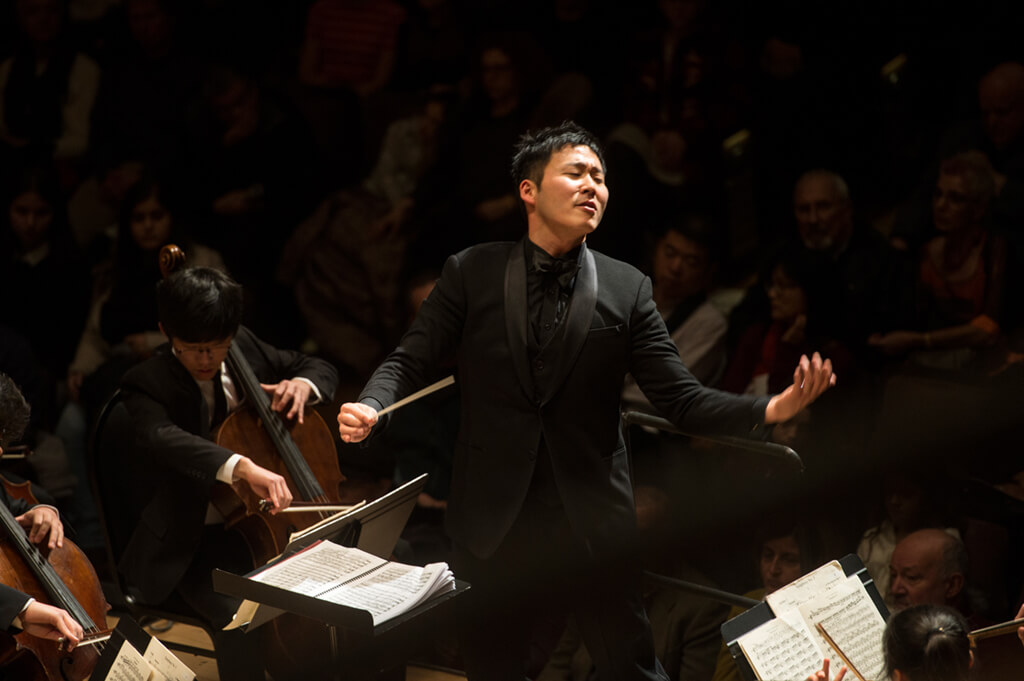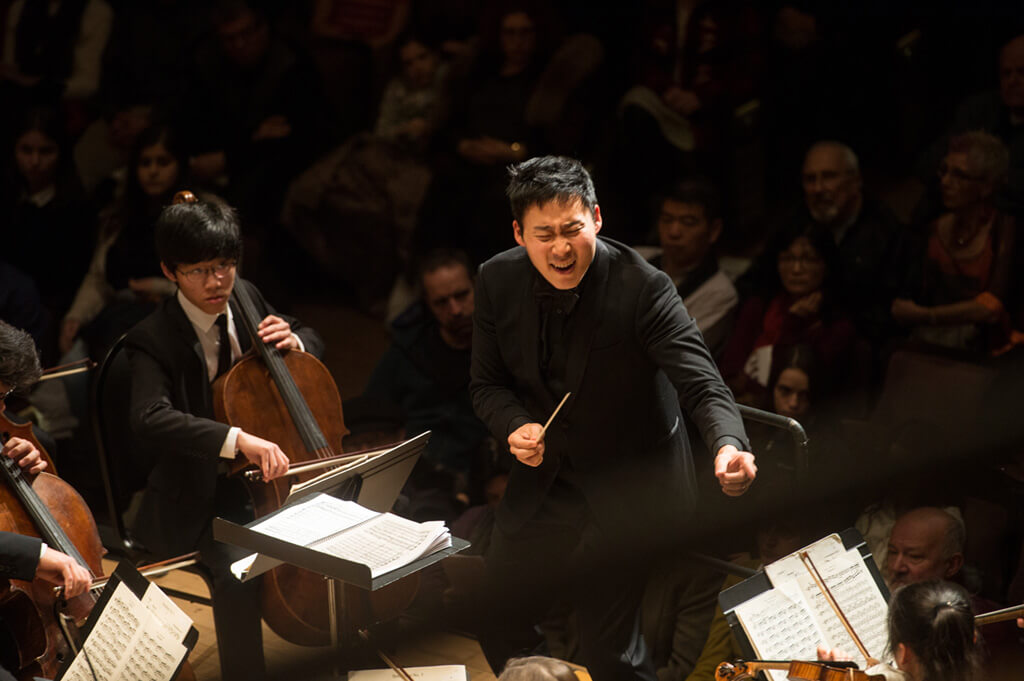
Toronto is still comparatively young by international standards. Today, the city offers much more variety and diversity to its residents and visitors, and the Toronto Symphony Youth Orchestra, fueled by its youthful enthusiasm and dedication, stands out with its unique mission: inviting young musicians aged 22 and under, to experience the specialized world of professional orchestral performance, and to present high-calibre performances.
Founded in 1974 by Victor Feldbrill with a tuition bill of 25 dollars per student per season, the Toronto Symphony Youth Orchestra has fostered many important musical figures nationally and internationally, (In 2015, on its 40th birthday, the program became tuition-free, bringing much joy to Maestro Feldbrill). Its yearly season is filled with a variety of activities, including weekly coaching and rehearsals, three self-presented concerts (fall, winter and spring), an annual concerto competition, guest masterclasses and the well-known (and always a guaranteed sell-out) side-by-side concert with the Toronto Symphony Orchestra at Roy Thomson Hall every spring.
Perhaps it is hard for the general public to imagine a fine-tuned orchestra of such young people, as it does take long and rigorous training to become a musician capable of passing auditions, trials, and finally becoming a tenured player. There are auditions for everything, as there are many sub-groups in a large orchestra, and for most established orchestras, there are even regular auditions for the substitute players list. There have been a few exceptional young players who did start working with international orchestras as teenagers, but generally, formal appointment winners would be in their late 20s to early 30s, as we saw with new TSO appointments, just last year.
So, where, exactly, did these new appointees get their early orchestral training? Many post-secondary schools with any music program would have a full-sized orchestra; however, these programs are not accessible for advanced players of a younger age. There are summer programs for chamber and full-sized youth orchestras, such as the National Youth Orchestra Canada. But only during the summer.
And that makes TSYO a very special program, where youngsters can come and experience orchestral life all year round, at a professional level.
It is expensive to run an orchestra as it requires certain (and large) commitments from the community; in 2015, tuition for the season was $730 per student, with the actual cost per student totalling around $5,000. From repertoire access (for scores, instruments access and musicianship required for the selections), to the logistics of rehearsal and concert spaces, and the actual education of musical and life skills to young musicians of all ages (currently the youngest member of TSYO is just 11 years old), the TSYO makes all of this work at a very high level, and that’s a rare combination. Many members are drawn to travel into the city every weekend for their regular Saturday rehearsal and Sunday concerts. Spending an hour or two on the road is normal for this enthusiastic bunch.

“I started with TSYO in grade 12, and my typical school year Saturdays went like this: drive into the city in the morning, take my private lesson in the morning, and attend TYSO rehearsal from 230-530pm, then drive back home. My parents were so supportive; without them, I would not have been able to play with TYSO until much later, when I moved into Toronto to study at the University of Toronto” (Lucy Nesbitt, French Horn)
“I went to Interprovincial Music Camp when I was in high school. I met David Hetherington there, who was then the TSYO cello coach. He suggested that I audition, and I participated with TSYO for two years before I went off to university. Like Lucy, I travelled every weekend- we lived two hours away from the city. And I still keep in touch with my TSYO friends, and many of them are now working in classical music. I still remember playing Bartok’s Concerto for Orchestra, and I really appreciated the quality of the repertoire I got to experience – and I am excited to see the Concerto for Orchestra on this year’s TYSO Spring Concert program.” (Kendal Lander, TSYO manager)
“I live in Uxbridge, and though I already participated in a chamber orchestra, I really wanted to play in a real orchestra. The TSYO audition was the first orchestral audition I did, where I had to prepare excerpts, and I felt rather apprehensive, as I have never done it before. The colours and timbres of a full orchestra are amazing, and I really look forward to the side-by-side concert in March. My weekends are also spent in Toronto, and I am happy that I get different experiences, from solo violin lessons, chamber music at the Taylor Academy, and TSYO.” (Duncan McDougall, Violin)
“For the decades I worked with TSYO, I’ve seen some real talents, and it’s amazing to see where they went from TSYO. I do believe (TSYO) is a top-tier program in North America, and I am so impressed with their dedication and performances. I also remember the tours, as the students were always full of energy, with occasional silliness…” (Harcus Hennigar, former TSO member and 15+ years brass coach of the TSYO)
“The importance of the TSYO did not become apparent to me until this year, when I left the orchestra for a brief period of time. As an Infrastructure Engineering student at the University of Toronto, I am expected to complete a 12-month long Professional Experience Year (PEY) between the third and fourth years of my degree; I decided that my 3-years with the orchestra were likely enough- this proved to be a poor decision. However, with lucky turn of events, I was invited back into the orchestra at the beginning of the group’s second term. Returning to the orchestra provided me with performance commitments that I could work toward and focus on. As a result, my playing has improved drastically since I returned to the orchestra in November.
The TSYO is a fantastic way for non-music major students to remain a part of the musical world and I am forever grateful for the opportunities it has provided me! The orchestra plays at such a high-quality, that someone who has played in the group for 3-years continues to learn new things about the genre every rehearsal and concert. “(Ben Makarchuk, French Horn)
“I was in TSYO when I was in high school, in the late 90s. I still remember the music we played: Prokofiev 5, Tchaikovsky 6, and the Serenade by Josef Suk. It was my side-by-side concert with TSO – playing Resphigi’s Pines of Rome, with Saraste conducting. My coach was right beside me, and he made sure that I was ready, especially when we had to tune down a string — he was so careful and kind to me. During that concert, I made my decision. I plunged into classical music seriously that day.” (Earl Lee, Resident conductor of TSO and TSYO conductor).
The season repertoire for TSYO is selected in consultation with the conductor and dedicated instrumental coaches, and the teaching team concentrates on two main things: equal involvement of all instruments, and an educational trajectory throughout the season.
“Sometimes we choose a piece that requires people to sit out for the first concert. And though it is hard, with everyone doing so many things and that we have to let a week pass through till the next rehearsal, we do have a camp weekend early in the season, where we try to create a chance for the group to come together- with much singing, of course. Then we try to build repertoire, to challenge all members, age and instrument-wise.” (Earl Lee)
In a fully packed George Weston Hall, North York, yesterday’s Winter Concert featured a magical (and tricky) work: Dukas’ The Sorcerer’ Apprentice, as the TSYO get ready to present it side-by-side with the TSO in their already-sold-out March concert, along with Dvorak’s 8th symphony and Mozart’s Flute Concerto (performed by Sarah Pollard 2016-17 TSYO Concerto Competition Winner).
The annual concerto competition winners are invited to return to join the TSYO as a soloist in subsequent seasons. The competition itself is fierce, as TSYO members are highly-driven, and they work extremely hard. Students often work for several months, even years on their concertos. But when Sarah joined them on the stage for the performance this weekend, the mutual respect between all parties touched everyone, as friends and family, and the orchestra erupted with huge cheers at the end of the concerto:
“It was an incredible experience playing with the TSYO yesterday. Both the orchestra and Maestro Lee were so supportive — the TSYO is a group of very musical and sensitive musicians. It was very inspiring to play with them.” (Sarah Pollard, Flute)
As an observer, I could not possibly think of a better environment to play a major concerto in public for your first complete performance. The bond from working together as young adults is quite special, and such connections do extend into lifetime friendships, as well as professional, collegial relationships. After all, all musicians cherish chamber music, especially with friends, as one of the most rewarding life experiences. And to have such a feeling of friendship with an orchestra as a soloist is a rarity.
- CRITIC’S PICKS | Classical Music Events You Absolutely Need To See This Week:April 29 – May 5 - April 29, 2024
- CRITIC’S PICKS | Classical Music Events You Absolutely Need To See This Week: April 22 – April 28 - April 22, 2024
- CRITIC’S PICKS | Classical Music Events You Absolutely Need To See This Week: April 15 – April 21 - April 15, 2024



